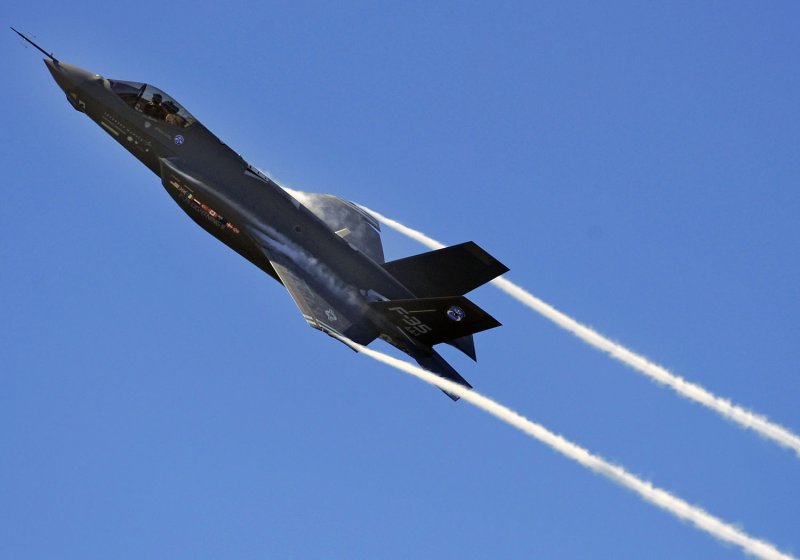An F-35 Lightning II Joint Strike Fighter test aircraft banks over the flightline at Eglin Air Force Base, Florida on, April 23, 2009. The aircraft is the first F-35 to visit the base which will be the future home of the JSF training facility. (UPI Photo/Julianne Showalter/US Air Force) |
License Photo
TEL AVIV, Israel, May 27 (UPI) -- The Israeli air force wants to send its top pilots to the United States to start training on Lockheed Martin's stealthy F-35 Joint Strike Fighter to speed up deployment of the 20 planes the Israeli Defense Ministry ordered in October 2010.
The Pentagon has already given the green light for Israel to purchase another 55 of the advanced, fifth-generation fighter.
All told, that's enough to equip three squadrons with the F-35, forming a new strategic spearhead for Israel's air power, which is largely equipped with Lockheed Martin F-16Is and Boeing F-15Is.
"The plane will provide the air force with new capabilities," air force commander Maj. Gen. Ido Nechushtan declared Wednesday at a conference at the Fischer Institute for Air and Space Strategic Studies near Tel Aviv.
"The F-35 is vital to our existence and will provide a dramatic leap in capabilities."
But the JSF program has been plagued with problems, delaying the project by two years and massive cost overruns that have pushed the cost per aircraft up from the original figure of $69 million to more than $120 million.
Despite the Israeli air force's enthusiasm for the aircraft, which commanders say will allow Israel to maintain its air supremacy over the countries regional adversaries, the acquisition has run into fierce opposition from legislators aghast at the ever-rising price-tag.
Meantime, the program continues to suffer setbacks that could delay its operational deployment in the Middle East.
Under the 2010 deal, in which payment for the aircraft will come from U.S. military aid to the Jewish state, Israel was to start taking delivery of the single-engine jets in 2015.
But that's not likely to happen until 2017 because of the constant development problems Lockheed Martin has experienced with the F-35, powered by the F135 engine built by Pratt and Whitney, a division of United Technologies Corp.
The JSF program took another blow recently when the U.S. Department of Defense disclosed that the aircraft, packed with advanced systems, may have less range than originally projected.
The F-35A model is currently estimated to have a combat radius, without in-flight refueling, of 584 nautical miles instead of the anticipated 690 nautical miles.
That could be a problem for the Israelis, who want the F-35 available for threatened pre-emptive, long-range strikes against Iran's nuclear installations.
These would involve in-air refueling operations to get the Israeli strike jets to their targets and back to their bases.
So having the F-35's range reduced from the original specifications could complicate what would be an already complex mission.
The JSF program is expected to cost the United States as much as $1 trillion over the coming two decades, the most expensive military project ever.
The plan is for 2,443 JSFs to be built, with different variants for the U.S. Air Force, Navy and Marine Corps.
U.S. allies such as Britain, Italy, Singapore, Japan, the Netherlands, Turkey and Australia have committed to buy the F-35, although some, like Japan, have said they may drop it because of the development problems.
That's likely to open the market for new strike aircraft that include the Eurofighter Typhoon built by a four-nation European aerospace consortium, Sweden's Saab Gripen and France's Dassault Rafale as well as Boeing's F/A-18E/F Super Hornet.
At one point recently, the Israelis were reported to be considering going for advanced models of the F-15I instead of F-35s because the Boeing fighters could be delivered sooner.
That option appears to have been dropped and the air force wants to start the one-year F-35 pilot training program in 2016, so that the flyers will be ready for operations when the jets are delivered in 2017.
"In terms of cost, we selected the best plane," Nechushtan told an audience of defense industry executives and senior defense officials Wednesday.
"The forecasted delays in the delivery of the F-35 to the (Israeli air force) is less dramatic than what's being said …
"We don't want to contemplate a situation in which the (Israeli air force) has jets that are inferior to what others have," Nechushtan commented.
But more trouble looms. U.S. Sen. John McCain, R-Ariz., the top Republican on the Senate Armed Services Committee, last week called the F-35 program a "train wreck" and suggested the Pentagon find an alternative to the JSF because of its astronomical costs.















